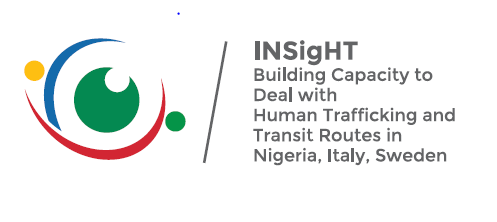Every year, thousands of women and girls fall into the hands of traffickers in their country of origin, on their way to Europe, within the European Union (EU) or during several phases of their migration journey. Given the underground nature of the criminal networks and poor data collection systems, the actual number of victims is difficult to assess and is likely to be underestimated. According to available EU data, the majority of human trafficking victims are still women and girls, with three-quarters of registered victims being female. Women and girls are primarily trafficked for sexual exploitation purposes.
Women and girls trafficked to Europe are often from non-EU countries, with Nigeria, China, Ukraine, Morocco and India making up the top-five nationalities from which victims originate.
In this blog, we share a partial extract of the stories of three Nigerian migrant women who – as presented in the e-book 'The Phenomenon of human trafficking along the Brenner route: Secondary movements and the system of protection for Nigerian women in the city of Bozen'[1] by the University of Venice IUAV – have experienced human trafficking, sexual exploitation, gender-based violence as well as the violence of institutional abandonment. These stories bring attention to the pernicious nature of human trafficking and the vicious circle caused by migration and asylum policies that are not always responsive to the vulnerability of migrant women and girls, with negative impacts on their lives.
The e-book was produced in the frame of the 'Building capacity to deal with human trafficking and transit routes in Nigeria, Italy and Sweden – INSighT’ project funded by the European Union through the Migration Partnership Facility (MPF) of ICMPD and implemented by IUAV in cooperation with Nigerian Women Association, Pathfinders Justice Initiative, Equality ATI and Associazione 2050.
The e-book focuses on intra-European movements and the exploitation of trafficked migrant women in the Italian-Austrian border of Brenner and the city of Bozen. The work is part of a series of five publications commissioned under INSigHT - which aims to strengthen the capacity of key anti-trafficking actors to address the phenomenon of human trafficking and secondary movements in Nigeria, Italy and Sweden, with a particular focus on Nigerian trafficked women and girls.
Beauty.
Beauty was a few months pregnant when she arrived in the Italian municipality of Bozen in the autumn of 2017, after being stopped on a train by multilateral police patrols. The train passed through the "Brenner route" – a route often taken by migrants trying to reach Northern Europe. Previously, Beauty had been a guest in a reception centre in the Apulia Region in Southern Italy, which she had to leave once she obtained a residence permit as an asylum seeker. In Italy, Beauty was exploited in the sex industry. The plan was for her to be trafficked to Germany to continue working under the same conditions. At the time that she was forced to leave, Beauty did not know she was pregnant. When she arrived in Bozen, Beauty was connected with a local anti-trafficking initiative that, after an assessment, decided that she was not to be admitted to the protection programme for victims of trafficking. They failed to recognize her condition as victim of trafficking. Therefore she was referred to the local social services to support her with her pregnancy. After giving birth in Bozen, supported by a group of volunteers, Beauty was transferred to another reception centre with mixed genders on the city's outskirts, which exposed her to a heightened risk of exploitation and harm. After spending eight months in the facility, Beauty was granted refugee status with the assistance of a legal professional and transferred to another centre in another region of Italy. Since then, she has been attending Italian language courses and participating in a work placement. She managed to reconnect with her partner who recognised paternity of the child – even though the pregnancy was the result of violence she had suffered during her exploitation – and they moved in together.
Faith.
Like Beauty – Faith had a similar experience and arrived in Bozen on a train. She arrived from Austria in December 2017 after being deported from Germany. She too was pregnant. As reported in the e-book, Faith was travelling with eight other people, including many women, and was holding a readmission document from Austria and a deportation order from Germany. Police discovered that she had been travelling on a goods train from Verona to Munich and stopped in Rosenheim. At Brenner the police escorted her to the roundabout marking the border between Italy and Austria, after taking her money and mobile phone as bail for attempting to cross the border, and suggested her she should travel to Bozen to ask for help. A few days later, she arrived in the city, where she was granted a temporary residence permit given her pregnancy and was placed in a hotel room, thanks to the support of volunteers, until her asylum application could be lodged. While her application was under review, it was discovered that Faith had entered the asylum system in 2015 and that she would need to re-apply, given the change in her circumstances. Her first assessment interview with the anti-trafficking team took place after several months. A decision was made not to admit her to the support programme for victims of trafficking since she was a mother with a child and a target group for social services instead. To make matters worse, Faith was prevented from accessing childcare services because she was not holding a valid resident permit. At the request of the asylum authority, which noted indicators of trafficking, the anti-trafficking team was asked to reassess her case. Faith was eventually granted a temporary residence permit for humanitarian protection and was subsequently transferred to a reception facility on the outskirts of Bozen, without employment and a source of income to provide for her daughter, and with no childcare support.
Joy.
Joy has so far experienced the most prolonged migration journey of the three women, having been trafficked from Nigeria to Europe, travelling through Portugal, Spain, France and Italy, since the age of 15. In Italy, she lived in Turin and became a sex worker until she fled to Spain in 1999, with a man with whom she fell in love and who promised to marry her. She gave birth to their baby girl in 2001. By 2001, she was in another exploitative situation, with the same man forcing her into prostitution. Joy decided to run away once again to Italy, where she worked in the sex industry in Catania and Rome, where she settled with the help of friends, to pay her debts for travelling back to Italy and provide for her daughter. In 2006, Joy was intercepted by Italian police without a valid residence permit and placed in a detention centre for three months. After her release, she returned to Nigeria with a false visa to place her daughter under the care of her grandmother. Joy was then forced to undertake another migration to Sweden and engage again in sex work until 2015, before deciding she would seek asylum. Shortly after, her asylum application was rejected, and she was deported to Nigeria. Dejected and vulnerable, Joy was imprisoned – returnees are frequently considered criminals as they often violated the immigration laws of destination countries – and released on bail by her uncle, who still blackmails her for money. Meanwhile, she had discovered that her own mother had been killed and her daughter taken to Europe. She indebted herself again to reach Italy through Niger and Libya. Once in Italy, Joy attempted a journey from Bologna to Munich but was intercepted by the police at Brenner and sent to Bozen. At Bozen, she reported her daughter missing and found out that she had been sent to a centre for unaccompanied foreign minors in the region. Joy had an assessment interview with the anti-trafficking team to seek support services, protection and special care as a victim of trafficking, but her case was closed as she did not meet the criteria to be admitted into the programme. As can be read in the publication of IUAV, because her migration history was long, the team assumed that she had repaid her debts and was no longer under the risk of exploitation. With the support of a volunteer group, she was accepted into a shelter and went through the asylum procedure. At the time of writing, Joy was forty years old, living in her rented flat and working as a caregiver, but suffering from several health issues related, among others, to the violence she had suffered and several interruptions of pregnancy. In December 2018, she embarked on filing an appeal with the European Court of Human Rights to seek redress for the injustices she suffered, including trafficking, exploitation and missed protection on the side of the Member States she had been transiting through.
Lessons.
All three of the women's stories have commonalities. Beauty, Faith and Joy all faced vulnerable situations, as women, migrants and lone mothers, exposed to trafficking, sexual exploitation, gender violence and institutional violence. All three spent protracted periods in reception facilities and detention centres that failed to protect them and their children and exposed them to further risks of exploitation. All three women were repeatedly forced into mobility by exploitation networks, but also by the lengthy and ineffective procedures of the asylum and social protection systems that did not grant prompt adequate refuge. All three journeys intersected at Bozen and were impacted by border policies and procedures enforced in the Brenner area and scarcely focused on protection. This was further aggravated by their exclusion from support services dedicated to victims of trafficking.
As reported in the IUAV publication, the stories of Beauty, Faith and Joy demonstrate the urgent need to improve the system of referrals between anti-trafficking initiatives and asylum and social systems at the local, national and transnational levels and to enhance the capacity of institutional stakeholders in the identification of victims of trafficking, particularly, but not only, in border areas. Learning from these experiences, the INSigHT e-book calls for the integration of anti-trafficking initiatives and asylum and social systems at all levels, especially concerning support interventions for women, mothers, children and other vulnerable groups to prevent the re-victimisation and re-trafficking of women and girls. The e-book highlights the crucial role that volunteers play in providing support to trafficked victims, and stresses that opportunities for close cooperation with these stakeholders be explored. The e-book also calls for improved access to regularisation, as the precarious legal status of people victims of trafficking and migrants in general is detrimental to ensuring access to services.
To find out more about INSigHT's work and read the full e-book on Brenner and other materials that have been produced as part of the initiative, visit INSigHT's online archive of publications and webinars.
These stories have been extracted from the e-book 'The Phenomenon of human trafficking along the Brenner route: Secondary movements and the system of protection for Nigerian women in the city of Bozen’. The opinions and views expressed in this blog are those of the authors of the e-book and do not necessarily reflect the views of the European Union and ICMPD.
[1] Semprebon M. and Caroselli S. (2021) “The phenomenon of human trafficking along the Brenner route: secondary movements and the system of protection for Nigerian women in the city of Bozen", Venice: SSIIM UNESCO Chair, University Iuav of Venice.

